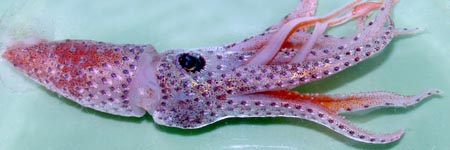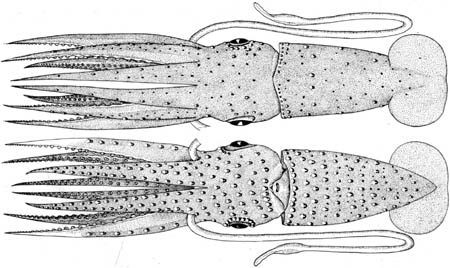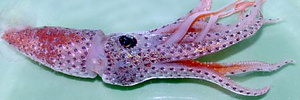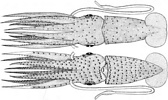Histioteuthis reversa
Richard E. Young and Michael VecchioneIntroduction
H. reversa is one of the most common species of histioteuthids in the North Atlantic. Its range extends into the eastern South Atlantic. The length of the gladius in the largest recorded female is 183 mm (Voss, 1969). Like many histioteuthids, major morphological changes occur at sexual maturity. In this species the females become much more elongate and develop an additional array of photophores.
Characteristics
- Photophores
- Large, compound photophores with posteriorly directed reflectors.
 image info
image infoFigure. Anteroventral mantle photophores of H. reversa, 29 mm ML, central North Atlantic, R/V G.O. SARS, MarEco cruise. Arrow points to the posterior reflector of one of the photophores. Photograph by R. Young.
- Arms IV with 4 longitudinal series of photophores on arm base (3 series of large photophores, dorsal series of small photophores
 image info
image info Figure. Ventral view of the base of arm IV of H. reversa, 29 mm ML, central North Atlantic, R/V G.O. SARS, MarEco cruise. Arrows point to the dorsal series of small photophores. Photograph by R. Young.
- Terminal group of large photophores on arms absent.
- Large, compound photophores with posteriorly directed reflectors.
Comments
More details of the description can be found here.Species of the reversa-group are distinguished by the following characters:
- Compound photophores
- Large and small photophores intermixed on ventral surface of mantle .
- 18 photophores (17 large and 1 small) around right eyelid.
- Beak
- Weakly developed median ridge on each lateral wall.
- Tubercles
- Absent.
H. reversa is most easily separated from other members of the reversa group by (1) the arrangement of photophores on arms IV (H. atlantica - 4 series, dorsal series of mixed sizes; H reversa - 4 series, dorsal series of small sizes; H. eltaninae - 3 series) and (2) from H. atlantica by the absence of simple, arm-tip photophores and from H. eltaninae by the short connective complex in their spermatophores and the presence of posterior reflectors (not described for H. eltaninae) on compound photophores.
The above information is from Voss (1969) and Voss, et al. (1998).
Nomenclature
H. elongata (Voss and Voss, 1962), described from a mature female, is a junior synonym (Voss, et al., 1998).
Life History
This series of drawings shows the remarkable elongation in shape of the female at maturity and the maturity-related increase in numbers of simple photophores (dark spots) on the mantle (Voss, et al., 1998)
 image info
image info Figure. Ventral views of growth stages of H. reversa. Top - 39 mm ML, same as title illustration. Middle - 85 mm GL, mature male, 43° 20'N, 59° 27'W. Bottom - 183 mm ML, mature female, 39° 21'N, 70° 41'W. Drawings from Voss, et al. (1998).
The drawings below show the abundance of simple, dark photophores on the head of mature males. To the left is a ventral view, 89 mm ML and to the right is a dorsal view, 107 mm GL (Voss, et al., 1998). These dark photophores are apparent in photographs of a mature male.
 image info
image info Figure. Ventral and dorsal views of the head of a mature male H. reversa. Left - Ventral view, 89 mm ML, 10° 52'N, 22° 09'W. Right - Dorsal view of the head of a mature male, 107 mm GL, 42° 55'N, 62° 13'W. Drawings from Voss, et al., 1998.
Distribution
Geographical distribution
H. reversa occurs throughout much of the Atlantic Ocean but is absent from the Caribbean Sea, the Gulf of Mexico and the South Subtropical Region. Voss, et al. (1998) suggest that the abundance of H. reversa near slopes and submarine topography is related to a preference for high productivity waters.
References
Voss, N. A. 1969. A monograph of the Cephalopoda of the North Atlantic: The family Histioteuthidae. Bull. Mar. Sci., 19: 713-867.
Voss, N.A., K. N. Nesis, P. G. Rodhouse. 1998. The cephalopod family Histioteuthidae (Oegopsida): Systematics, biology, and biogeography. Smithson. Contr. Zool., 586(2): 293-372.
Title Illustrations
| Scientific Name | Histioteuthis reversa |
|---|---|
| Location | Central North Atlantic |
| Comments | Photographed aboard the R/V G. O. SARS, Mar-Eco cruise. |
| View | Ventral |
| Size | 29 mm ML |
| Copyright | © 2004 Richard E. Young |
| Scientific Name | Histioteuthis reversa, Histioteuthis reversa (2) |
|---|---|
| Location | 41° 27''N, 27° 35''W, 41° 27''N, 27° 35''W (2) |
| Reference | from Voss, N. A. 1969. A monograph of the Cephalopoda of the North Atlantic: The family Histioteuthidae. Bull. Mar. Sci. 19:713-867. printed with permission |
| Sex | m, m (2) |
| View | ventral, dorsal (2) |
| Size | 39 mm ML, 39 mm ML (2) |
| Copyright | © 1969 Bulletin of Marine Science |
About This Page
Drawings by Voss (1969) printed with the Permission of the Bulletin of Marine Science.
Richard E. Young
Dept of Oceanography
University of Hawaii
Honolulu, Hawaii 96822
USA
National Marine Fisheries Service
Systematics Laboratory
National Museum of Natural History
Washington, D. C. 20560
USA
Page copyright © 2000 Richard E. Young and
Citing this page:
Young, Richard E. and Vecchione, Michael. 2000. Histioteuthis reversa . Version 01 January 2000 (under construction). http://tolweb.org/Histioteuthis_reversa/19791/2000.01.01 in The Tree of Life Web Project, http://tolweb.org/










